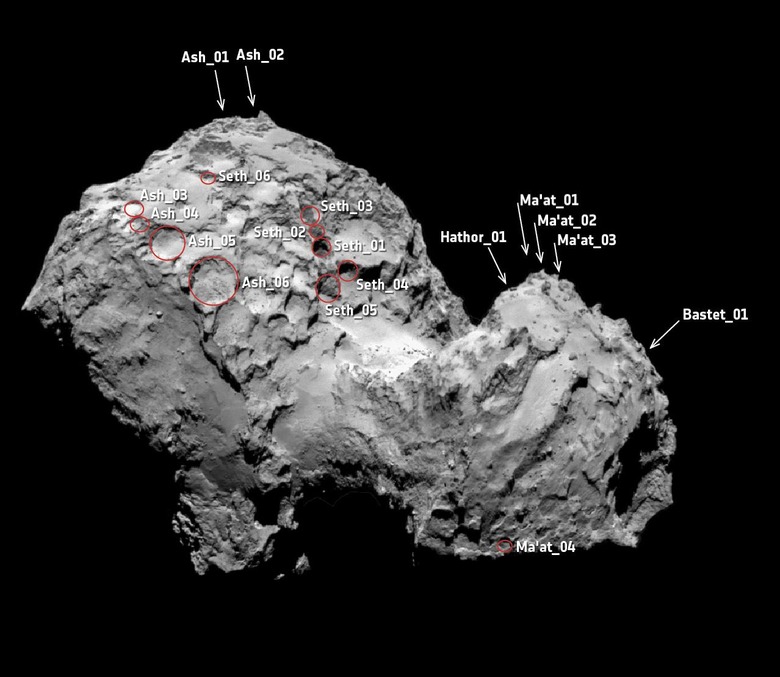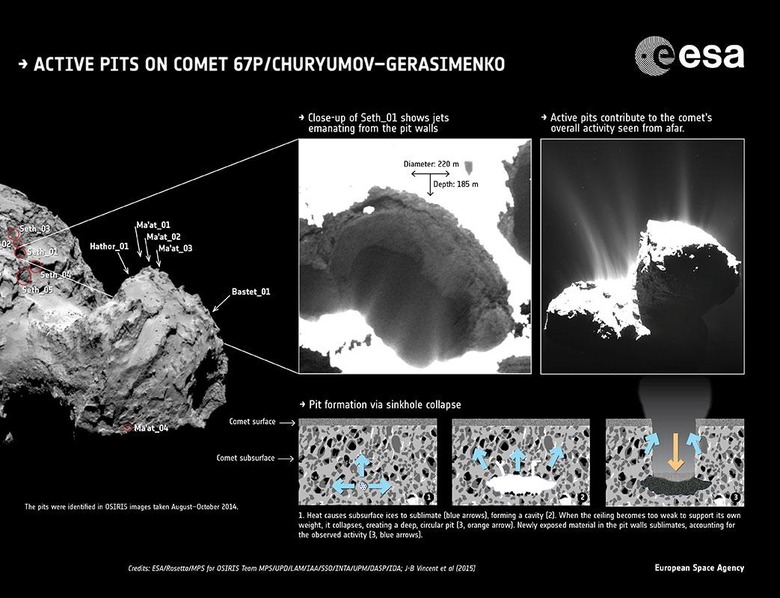Rosetta Finds Sinkholes That Could Swallow A Pyramid
Rosetta continues its extended mission in capturing information on its nearby comet this week, finding massive sinkholes in the process. A number of these massive "cavities" have shown themselves in comet 67P/Churyumov-Gerasimenko. These holes appear as deep as 590 feet (180 meters) and as wide as 656 feet (200 meters) in diameter. While scientists are not certain why these pits are appearing, lead researcher Jean-Baptiste Vincent suggested that it could be because of the heat of the sun, this heat creating jets of surface-collapsing dust.
As Rueters' Irene Klotz suggests, the sinkholes appearing on this comet are tall enough (and nearly wide enough) to swallow the Great Pyramid of Giza.

The deepest sinkholes on this comet are more than wide and tall enough to swallow the Luxor pyramid in Las Vegas at just 111m tall and around 180m wide.
ABOVE (hero image): "Pits Ma'at 1, 2 and 3 on Comet 67P/Churyumov–Gerasimenko show differences in appearance that may reflect their history of activity. While pits 1 and 2 are active, no activity has been observed from pit 3. The young, active pits are particularly steep-sided, whereas pits without any observed activity are shallower and seem to be filled with dust. Middle-aged pits tend to exhibit boulders on their floors from mass-wasting of the sides."
"We see jets arising from the fractured areas of the walls inside the pits," said Jean-Baptiste Vincent, from the Max Planck Institute for Solar System Research. "These fractures mean that volatiles trapped under the surface can be warmed more easily and subsequently escape into space."
In the image below, the ESA depicts a variety of active pits on the surface of the comet. The term "active" here means that dust is spraying outward into space from below the surface of the comet.

ABOVE: "Eighteen pits have been identified in high-resolution OSIRIS images of Comet 67P/Churyumov–Gerasimenko's northern hemisphere. The pits are named after the region they are found in, and some of them are active. The context image was taken on 3 August 2014 by the narrow-angle camera from a distance of 285 km; the image resolution is 5.3 m/pixel."

ABOVE (right, top): "Context image showing fine structure in the comet's jets as seen from a distance of 28 km from the comet's surface on 22 November 2014. The image was taken with the OSIRIS wide-angle camera and has a resolution is 2.8 m/pixel. In both images the contrast is deliberately stretched in order to see the details of the activity. The active pits in this study contribute a small fraction of the observed activity."
At this time it does not appear that any pits have formed near the Philae lander on the comet's surface. Stay tuned with SlashGear's Rosetta tag portal for more information from the planet of an alien rock!
